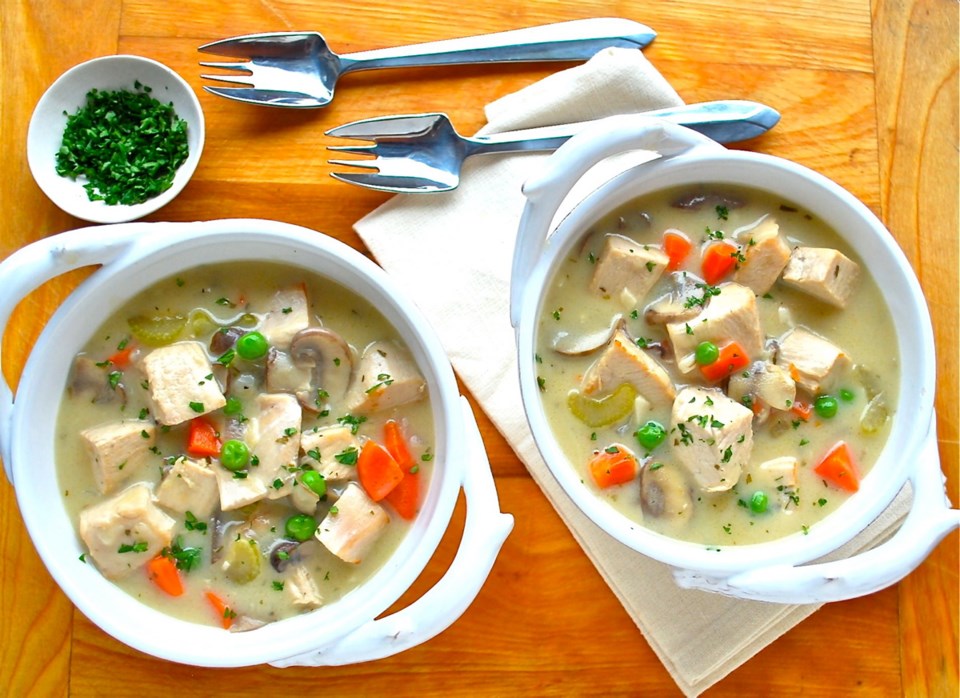It’s Thanksgiving and many people around the Island will be roasting a turkey for dinner. If you’re among them, and bought a large one, when the meal is done you might start to wonder what to do with the all that leftover meat.
One can, of course, make sandwiches with it, simmer some in a soup or maybe make a pot of turkey chili. But, if you want another option that sounds a bit more gourmet, use some of that leftover meat to make turkey fricassee.
According to the Oxford Companion to Food, fricassee is a French term that long ago passed into English and originally meant: “any meat fried in a panne.”
Panne means pan. And according to the New Food Lovers Companion, butter is what the bits of meat, such as chicken, veal or even rabbit, were fried in, before being stewed with vegetables.
What makes fricassee different than a dark and rich beef stew, for example, is that you don’t deeply brown the meat before stewing it with the other ingredients.
According to Michael Ruhlman’s informative book, The Elements of Cooking, a fricassee is considered a white stew in which the meat has been sautéed without colour to begin the cooking. In other words, the meat is simply enriched by more slowly cooking it in butter first.
You usually start making fricassee with raw meat, but I successfully used cubes of cooked, roast turkey, instead. After sautéing it to enhance its flavour as just noted, the meat was simmered in a thickened mixture that was rich with mushrooms and vegetables.
Some recipes for fricassee use a rich mix of cream and egg yolks to thicken it, which is stirred in near the end cooking. I did not do that, opting to take a simpler approach and just use flour to thicken it.
You can serve the fricassee on or with such things as egg noodles, rice or boiled miniature potatoes.
Turkey Fricassee
Use leftover roast turkey to make this inviting sauté-and-simmer dish.
Any leftover fricassee, once cooled to room temperature, will freeze well.
Preparation time: 20 minutes
Cooking time: About 40 minutes
Makes: Four servings
3 Tbsp butter
1 Tbsp olive oil
2 cups cooked turkey meat, cut into 1/2- to 1-inch cubes
6 medium white or brown mushrooms, thinly sliced
1 medium carrot, diced (cut into 1/4 cubes)
1/2 cup diced onion
1 medium celery rib, thinly sliced widthwise
1 large garlic clove, minced
1/2 tsp dried tarragon or thyme
3 Tbsp all-purpose flour
2 2/3 cups turkey or chicken stock
1Ú2 cup light cream or milk
1/3 cup frozen peas
• salt and white pepper to taste
• chopped fresh parsley, to taste (optional)
Place the butter and oil in a medium pot (mine was eight inches wide) set over medium heat. When the butter is melted, add the cubed turkey and sauté until it’s enriched with the flavour of the butter, about four to five minutes. Lift the turkey out of the pot with a slotted spoon and set on a plate.
Add the mushrooms, carrot, onion, celery, garlic and tarragon (or thyme) to the remaining butter/oil in the pot and cook and stir until the mushrooms are tender, about five to seven minutes. Mix in the flour and cook and stir one to two minutes more.
Slowly, while stirring, pour in 2/3 cup of the stock. When mixture is very thick, slowly mix in the rest of the stock. Return the turkey to the pot and bring fricassee to a gentle simmer (small bubbles should just break on the surface). Adjust the heat as needed to maintain that simmer, and then cook the fricassee, uncovered, 20 minutes. Mix in the cream (or milk) and peas and warm them through for a few minutes.
Season the fricassee with salt and pepper and its ready. If desired, top servings of the fricassee with chopped fresh parsley, to taste.
Eric’s options: Some fricassee recipes call for wine. If you prefer, when asked to mix in the 2/3 cup of the stock, replace 1/3 cup of stock with 1/3 cup white wine.
Eric Akis is the author of eight cookbooks, including seven in his Everyone Can Cook series. His columns appear in the Life section Wednesday and Sunday.



